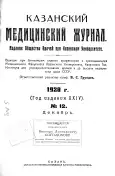К вопросу о патолого-анатомических изменениях при свободных пересадках кожи в другие органы и ткани
- Авторы: Цимхес И.Л.1,2
-
Учреждения:
- Патолого-анатомический институт Казанского гос. университета
- Хирургическая клиника Казанского гос. института для усов. врачей
- Выпуск: Том 24, № 12 (1928)
- Страницы: 1294-1301
- Тип: Статьи
- URL: https://bakhtiniada.ru/kazanmedj/article/view/95798
- DOI: https://doi.org/10.17816/kazmj95798
- ID: 95798
Цитировать
Полный текст
Аннотация
В хирургической практике давно известны попытки замещения кожей слизистых или серозных оболочек. Известны также случаи пользования кожею вместо обычного применения фасции. Так, О. Loewe (1913) у 9 больных с паховыми грыжами, retroflexio uteri и другими заболеваниями вместо фасции вшивал кусочки кожи разной длины после удаления ее поверхностного эпителиального слоя. В 1927 г. проф. В. Л. Боголюбов применил в 17 случаях свободную пересадку кожи в виде жгутиков при гастропексиях, выключении кишки, при anus praeternaturalis и для сужения бедренного или пахового канала, при грыжах; в 4 случаях проф. Боголюбовым было произведено сужение заднепроходного отверстия кожным жгутиком при выпадениях прямой кишки. Во всех оперированных случаях получилось вживление пересаженных жгутиков наряду с полным заживлением раны.
Ключевые слова
Полный текст
Открыть статью на сайте журналаОб авторах
И. Л. Цимхес
Патолого-анатомический институт Казанского гос. университета; Хирургическая клиника Казанского гос. института для усов. врачей
Автор, ответственный за переписку.
Email: info@eco-vector.com
Россия
Список литературы
- Bier. D. med. Woch., 1917—1919.
- Боголюбов. Нов. хирург. арх., т. XIII.
- Боголюбов и Овсянников. Vir. Arch., Bd. 192, 1902.
- Braun. Berl. klin. Woch., 1921, № 14.
- Blümberg. Deut. Zeit. f. Chir., 1894.
- Enderlen. Deut. Zeit. f. Chir., Bd. 45, 1897.
- Fischer. Verh. d. Deut. Pat. Ges., Bd. 10, 1906.
- Kaufmann. Vir. Arch., Bd 97, 1884.
- Krauss. Arch. f. mikr. Anath., Bd. 79, 1912.
- Kurtzahn. Arch. f. klin. Chir., Bd. 138, 1925.
- Loewe. Münch. med. Woch., 1913.
- Львов. Дисс. Казань, 1884.
- Mangoldt. Deut. med. Woch., 1895, № 48.
- Никольский. Хирургия, т. 25, 1909.
- Pels-Leusden. Verh. d. Deut. Ges. f. Chir., Bd. 46, 1922.
- Петpов. Рус. врач, 1907, №7.
- Покотило. Дисс. М., 1908.
- Pribram и Finger. Arch. f. klin. Chir., Bd. 118, 1921.
- Rehn, Lexer. Die freien Transplantation, 1924.
- Reschke. Verh. d. Dent. Ges. f. Chir., Bd.46,1922.
- Тизенгаузен. Дисс. Одесса, 1910.
- Тихов. Мед обозр., 1896, №7.
- Traina. Centr. f. pat. Anat., Bd. 13, 1902.
- Wildegans. Arch. f. klin. Chir., Bd. 120, 1922.
- Wulstein. Verh. d. Deut. Ges. f. Chir., 1908.







